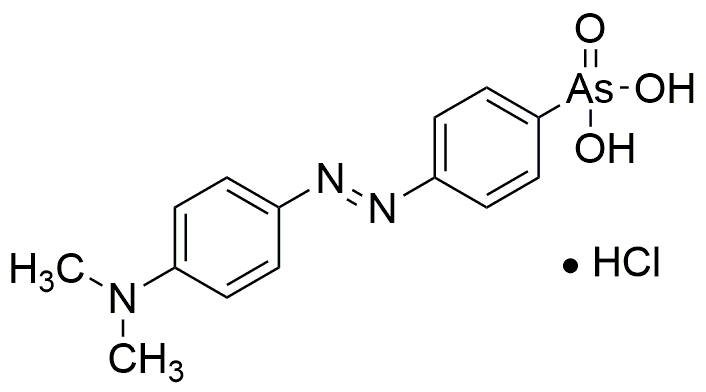4-(4-Dimethylaminophenylazo)phenylarsonic acid hydrochloride is widely utilized in research focused on:
- Analytical Chemistry: This compound serves as a reagent in colorimetric assays, allowing for the detection and quantification of various analytes in complex mixtures, which is essential for quality control in laboratories.
- Pharmaceutical Development: It is employed in drug formulation research due to its properties that can enhance the solubility and stability of active pharmaceutical ingredients, making it valuable in the development of effective medications.
- Environmental Monitoring: The compound is used in studies assessing the presence of arsenic in water samples, helping to ensure compliance with safety regulations and protect public health.
- Biological Research: It acts as a labeling agent in biological assays, facilitating the visualization of proteins and other biomolecules, which aids researchers in understanding cellular processes.
- Textile Industry: This chemical is applied in dyeing processes, providing vibrant colors while maintaining durability, which is crucial for producing high-quality textiles.
General Information
Properties
Safety and Regulations
Applications
4-(4-Dimethylaminophenylazo)phenylarsonic acid hydrochloride is widely utilized in research focused on:
- Analytical Chemistry: This compound serves as a reagent in colorimetric assays, allowing for the detection and quantification of various analytes in complex mixtures, which is essential for quality control in laboratories.
- Pharmaceutical Development: It is employed in drug formulation research due to its properties that can enhance the solubility and stability of active pharmaceutical ingredients, making it valuable in the development of effective medications.
- Environmental Monitoring: The compound is used in studies assessing the presence of arsenic in water samples, helping to ensure compliance with safety regulations and protect public health.
- Biological Research: It acts as a labeling agent in biological assays, facilitating the visualization of proteins and other biomolecules, which aids researchers in understanding cellular processes.
- Textile Industry: This chemical is applied in dyeing processes, providing vibrant colors while maintaining durability, which is crucial for producing high-quality textiles.
Documents
Safety Data Sheets (SDS)
The SDS provides comprehensive safety information on handling, storage, and disposal of the product.
Product Specification (PS)
The PS provides a comprehensive breakdown of the product’s properties, including chemical composition, physical state, purity, and storage requirements. It also details acceptable quality ranges and the product's intended applications.
Certificates of Analysis (COA)
Search for Certificates of Analysis (COA) by entering the products Lot Number. Lot and Batch Numbers can be found on a product’s label following the words ‘Lot’ or ‘Batch’.
*Catalog Number
*Lot Number
Certificates Of Origin (COO)
This COO confirms the country where the product was manufactured, and also details the materials and components used in it and whether it is derived from natural, synthetic, or other specific sources. This certificate may be required for customs, trade, and regulatory compliance.
*Catalog Number
*Lot Number
Safety Data Sheets (SDS)
The SDS provides comprehensive safety information on handling, storage, and disposal of the product.
DownloadProduct Specification (PS)
The PS provides a comprehensive breakdown of the product’s properties, including chemical composition, physical state, purity, and storage requirements. It also details acceptable quality ranges and the product's intended applications.
DownloadCertificates of Analysis (COA)
Search for Certificates of Analysis (COA) by entering the products Lot Number. Lot and Batch Numbers can be found on a product’s label following the words ‘Lot’ or ‘Batch’.
*Catalog Number
*Lot Number
Certificates Of Origin (COO)
This COO confirms the country where the product was manufactured, and also details the materials and components used in it and whether it is derived from natural, synthetic, or other specific sources. This certificate may be required for customs, trade, and regulatory compliance.


